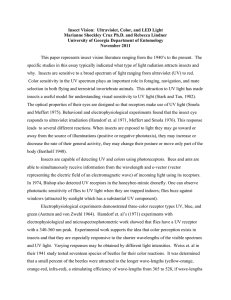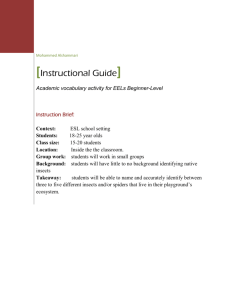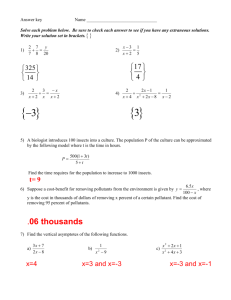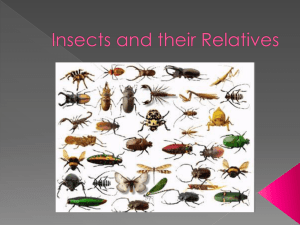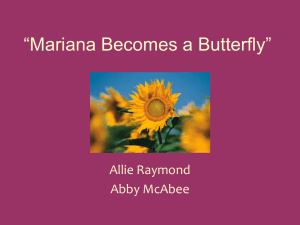Insect Vision: Ultraviolet, Color, And Led Light Marianne
advertisement
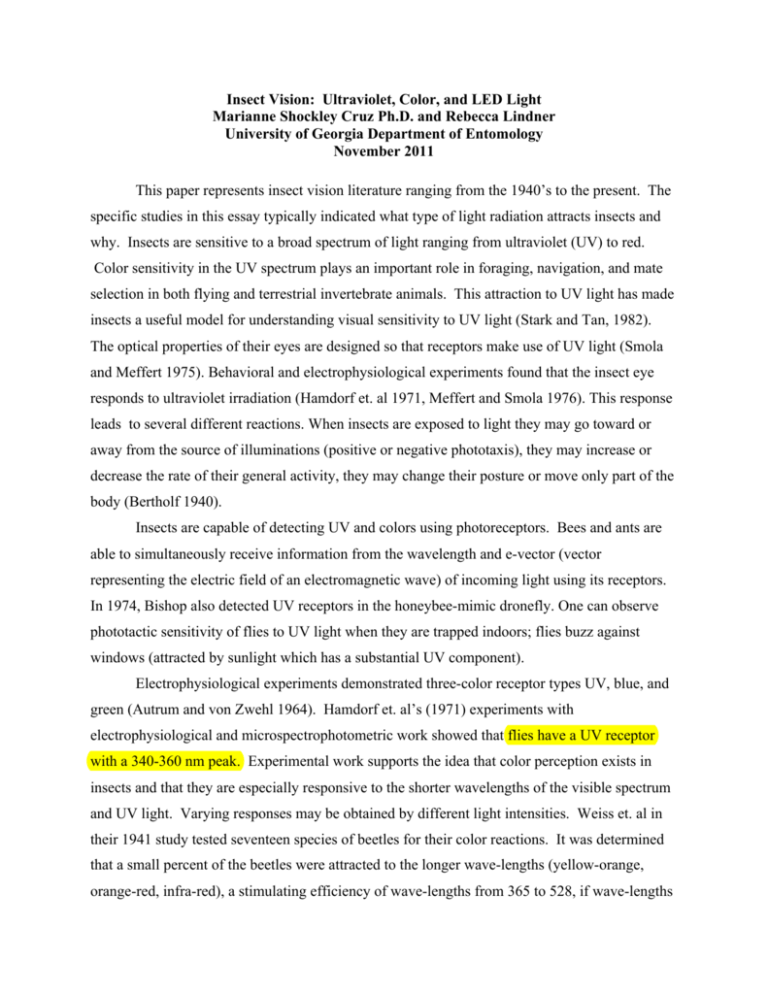
Insect Vision: Ultraviolet, Color, and LED Light Marianne Shockley Cruz Ph.D. and Rebecca Lindner University of Georgia Department of Entomology November 2011 This paper represents insect vision literature ranging from the 1940’s to the present. The specific studies in this essay typically indicated what type of light radiation attracts insects and why. Insects are sensitive to a broad spectrum of light ranging from ultraviolet (UV) to red. Color sensitivity in the UV spectrum plays an important role in foraging, navigation, and mate selection in both flying and terrestrial invertebrate animals. This attraction to UV light has made insects a useful model for understanding visual sensitivity to UV light (Stark and Tan, 1982). The optical properties of their eyes are designed so that receptors make use of UV light (Smola and Meffert 1975). Behavioral and electrophysiological experiments found that the insect eye responds to ultraviolet irradiation (Hamdorf et. al 1971, Meffert and Smola 1976). This response leads to several different reactions. When insects are exposed to light they may go toward or away from the source of illuminations (positive or negative phototaxis), they may increase or decrease the rate of their general activity, they may change their posture or move only part of the body (Bertholf 1940). Insects are capable of detecting UV and colors using photoreceptors. Bees and ants are able to simultaneously receive information from the wavelength and e-vector (vector representing the electric field of an electromagnetic wave) of incoming light using its receptors. In 1974, Bishop also detected UV receptors in the honeybee-mimic dronefly. One can observe phototactic sensitivity of flies to UV light when they are trapped indoors; flies buzz against windows (attracted by sunlight which has a substantial UV component). Electrophysiological experiments demonstrated three-color receptor types UV, blue, and green (Autrum and von Zwehl 1964). Hamdorf et. al’s (1971) experiments with electrophysiological and microspectrophotometric work showed that flies have a UV receptor with a 340-360 nm peak. Experimental work supports the idea that color perception exists in insects and that they are especially responsive to the shorter wavelengths of the visible spectrum and UV light. Varying responses may be obtained by different light intensities. Weiss et. al in their 1941 study tested seventeen species of beetles for their color reactions. It was determined that a small percent of the beetles were attracted to the longer wave-lengths (yellow-orange, orange-red, infra-red), a stimulating efficiency of wave-lengths from 365 to 528, if wave-lengths (violet-blue, blue, blue-blue-green) are considered as one unit, ~60% reacted positively to that band, making this range a region of maximum stimulation. Intensity of light may also be a factor. There has been extensive research done finding wavelengths that attract insects, which supports the hypothesis that they are not attracted to some wavelengths. The use of light as a navigational or directional orientation cue has been studied extensively in diurnal insects (Pfeiffer and Homberg 2007) but has been investigated for only a few insects active in crepuscular or nocturnal light with inherently diverse irradiance spectra (Warrant et. al, 2004). Higgins et. al described how UV light is used for navigational activities of insects (1976). Many insects forage at twilight when blue light dominates the irradiance spectrum of the sky. Under starlight, irradiance spectra are ‘red-shifted’ and strongly influenced by the presence or absence of the moon (Johnsen et. al 2006). Blue wavelengths become dominant as the solar elevation angle decreases and the sun disappears below the horizon. For 12 h between sunset and astronomical twilight, blue-shifted twilight offers a constant polarization pattern in non-cloudy skies that provides insects with orientation cues (Cronin et. al 2006). Menzel (1979) demonstrated that behavioral evidence suggests that bees also use UV patterns in the sky for orientation and navigation. In behavioral studies, Indian Meal Moths were most strongly attracted to UV (365 nm) and green (500 nm) lights, suggesting that the eyes are potentially dichromatic. High-intensity light was more effective than low-intensity light in attracting moths (Stremer 1959). There are also behavioral studies that suggest that bees and monarch butterflies use UV patterns in the sky for orientation and navigation (Edrich et. al 1979 and Froy et. al 2003). The specialized eye of the desert locust, Schistocerca gregaria (Forskal), with peak sensitivity for polarized blue light, is likely an adaptation for nocturnal flight (Homberg 2004). Moonlight and artificial light are also known to serve as directional cues. Black carpenter ants, Camponotus pennsylvanicus (DeGeer), can use moonlight or artificial light to orient themselves along trails (Klotz and Reid 1993). Similarly, polarized moon light as well as non-polarized natural and artificial light sources serve foraging dung beetles, Scarbaeus zambesianus (Peringuey) as orientation cues when returning home (Dacke et. al 2004). Attraction of nocturnal moths to light may be due to a shift in orientation response from moonlight to artificial light (Baker and Sadovy 1978). A light-emitting diode (LED) is a semiconductor light source. LEDs are used as indicator lamps in many devices and are increasingly used for other lighting. Originally, LEDs were introduced as a practical electronic component in 1962 and early LEDs emitted lowintensity red light. However, modern versions are available across the visible, ultraviolet and infrared wavelengths, with very high bright light. Cowan and Gries (2009) tested the hypothesis that moths use wavelengths of visible blue/violet light as orientation cures that trigger phototactic responses. In a four choice lab experiment, blue light was more effective than green, orange, or red light. In subsequent experiments that tested LEDs emitting peak wavelengths in the blue/violet light range, 405 nm was significantly more effective than 435-, 450-, or 470-. Based on our knowledge of insect vision and their subsequent sensitivity and photo receptivity to UV light and colors across the visible spectrum, it can be assumed that if the LED light emission is towards the higher end of the visible spectrum (> 550 nm) this may be out of the range of vision for most insects. However if the LED light is within this range you can assume that it is visible by insects. Furthermore, there was little evidence of insect attraction to infrared radiation. Below is a figure depicting the wavelengths and their corresponding colors. Note how on the second figure (labeled figure 3) lights contain many different wavelengths. http://www.olympusmicro.com/primer/lightandcolor/lightsourcesintro.html LED Reference List Autrum, H., and V. von Zwehl. Spektrale Empfmdlichkeit einzelner Sehzellen des Bienenauges. Z. vergl. Physiol. 1964. 48: 357-384. Bertholf, L.M. Reactions to Light in Insects. Bios.1940. 11. pp. 39-43. Baker RR & Sadovy R. Distance and nature of light-trap response of moths. Nature. 1978. 276: 818-821. Bishop, L. G. An Ultraviolet Photoreceptor in a Dipteran Compound Eye. J. Comp. Physiol. 1974. 91. 267-275. Cowan T & Gries G. Ultraviolet and violet light: attractive orientation cues for the Indian meal moth, Plodia interpunctella. Entomologia Experimentalis et Applicata. 2009. 131: 148158. Cronin TW, Warrant EJ & Greiner B. Celestial polarization patterns during twilight. Applied Optics. 2006. 45: 5582-5589. Dacke, M., Byrne, MJ., Scholtz C. and Warrant EJ. Lunar orientation of a beetle. Proc. R. Soc. Lond. B. 2004 271, 361-365. Edrich, W., Neumayer, C., and von Elverson, D. J. Comp. Physiol. 1979. 134. 151-157. Froy, O., Gotter, A.L., Casselman, A.L., and Reppert, S.M. (2003). Illuminating the circadian clock in monarch butterfly migration. Science. 2003. 300, 1303–1305. Hamdorf, K., Schwemer, J., and Gogala, M. Nature. 1971. 231, 458-459. Higgins, NP, Kato, K., Strauss, B., J. Mol. Biol. 101, 417 (1976). Homberg U. In search of the sky compass in the insect brain. Naturwissenschaften. 2004. 91: 199-208. Johnsen, S., Kelber, A., Warrant, E., Sweeney, A. M., Widder, E. A., Lee, R. L. and HernandezAndres, J. Twilight and nocturnal illumination and its effects on color perception by the nocturnal hawkmoth Deilephila elpenor. J. Exp. Biol. 2006. 209, 789-800. Klotz, J.H., Reid, B.L., 1993. Nocturnal orientation in the black carpenter ant Camponotus pennsylvanicus (DeGeer) (Hymenoptera: Formicidae). Insectes Soc. 40, 95–106. Meffert, P. and Smola, U. Electrophysiological measurements of spectral sensitivity of central visual cells in eye of blowfly. Nature. 1976. 260 (5549), p. 342-344. Menzel, R. Spectral Sensitivity and Color Vision in Invertebrates (1979) In Handbook of Sensory Physiology (Edited by H. Autrum), 7-6A, 503-566. Springer, Berlin. Pfeiffer K, Homberg U. Coding of azimuthal directions via time compensated combination of celestial compass cues. Curr Biol. 2007. 17:960–965. Smola, U. and Meffert, P. A Single-peaked UV-Receptor in the Eye of Calliphora erythrocephala. J. Comp. Physiol. 103. (1975) 353-357. Stark, W. S. and Tan, K.W.P. Ultraviolet light: photosensitivity and other effects on the visual system. Photochem. Photobiol. 1982. 36. pp. 371–380. Stremer RA. Spectral response of certain stored-product insects to electromagnetic radiation. Journal of Economic Entomology. 1959. 52: 888-892. Warrant E, Kelber A, Gislen A, Greiner B, Ribi W & Wcislo W. Nocturnal vision and landmark orientation in a tropical halictid bee. Current Biology. 2004. 14: 1309-1318. Weiss, HB., Soraci, FA, and McCoy, EE. Notes on the reactions of certain insects to different wave-lengths of light. Journal of the New York Entomological Society. 1941. Vol. 49. No. 1. pp 1-20.
